INTRODUCTION
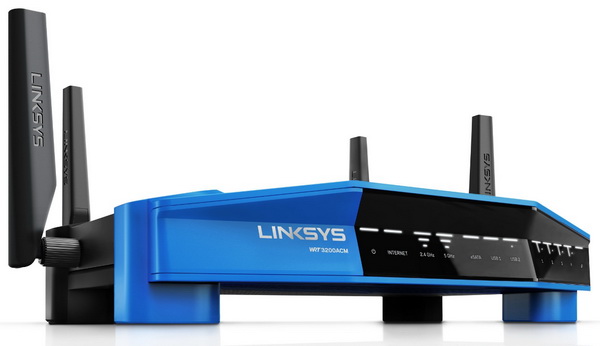
It's no secret that wired connectivity is more reliable, secure and faster compared to wireless (perhaps even healthier) but the second is a lot more convenient which is also why it keeps gaining ground over the first (at least in households). Of course we all know just how annoying it is when we don't have good WiFi signal everywhere we go (i get especially annoyed when i go someplace to eat or have a drink and not only is my 4G signal extremely weak but so is their WiFi signal) so using a high-performance modem/router and/or access point is obviously extremely important. In late 2016 Linksys expanded their very popular WRT line of high-performance routers with the WRT3200ACM AC3200 MU-MIMO Gigabit Wi-Fi model which is also here with us today.
The Linksys brand has pioneered wireless connectivity since its inception in 1988 with its leading innovation and engineering strategies, and best-in-class technology, design, and customer service. Linksys enables a connected lifestyle for people at home, at work and on the move, and with its award-winning products, simplifies home control, entertainment, security and Internet access through innovative features and a growing application and partner ecosystem. Linksys is part of Belkin International.
The WRT3200ACM is yet another AC3200 router that can output throughput speeds of up to 600Mbps on the 2.4GHz band (802.11n) and 2600Mbps on the 5GHz band (802.11ac) simultenously via 4 dual-band high-gain detachable antennas. It's also virtually identical to the WRT1900AC and the WRT1900ACS models which we have already reviewed but since it so happens it's one of the sturdiest (not to mention best looking) enclosures we've ever seen i too don't see the reason as to why they should change it. Inside this very familiar enclosure Linksys has placed a Marvell Armada 88F6820 dual-core CPU clocked at 1.8GHz, 512MB of DDR3 RAM (our sample had a single Micron module inside), 256MB NAND flash (Spansion branded), two Marvell Avastar 88W8964 WiFi processors (featuring integrated ARM® Dual-Core Cortex A9 CPU's and 128MB DRAM cache modules) and two Skyworks amplifiers (SKY85309 for the 2.4GHz band and SKY85728 for the 5GHz band). Thanks to its Avastar processors not only does the WRT3200ACM support MU-MIMO and beamforming technologies but it also supports the brand new tri-stream 160MHz bandwidth technology which basically doubles the 80MHz channel width on the 5GHz band to achieve faster throughput speeds. The only "downside" with that is that there aren't really many devices that support it yet. Finally in terms of connectivity the WRT3200ACM has 4 Gigabit Ethernet ports, Gigabit WAN port, USB 3.0 port and an eSATA/USB 2.0 port.
SPECIFICATIONS AND FEATURES

PACKAGING AND CONTENTS
The front of the box has a large picture of the WRT3200ACM right over its main features and beneath the company logo.
The rear of the router with all of its connectors is showcased on the left side of the box.
A detailed specifications list is placed at the base of the box.
The main product features are also listed on the right side of the box in 4 languages.
Moving at the rear of the box we see a drawing showcasing the brand new tri-stream 160, MU-MIMO and open-source ready features.
Packaging is once again perfect with two black foam pieces keeping the router safe during shipping.
Along with the WRT3200ACM you will also get 4 detachable antennas, wall power adapter, Ethernet cable, software CD and a quick start guide.
THE WRT3200ACM
Measuring 245.87mm in width, 193.80mm in length and 51.82mm in height (without antennas) the 798g heavy WRT3200ACM is virtually identical with its predecessors.
Once again at the front we find the product name right next to the white activity LEDs for power on/off, internet, Wi-Fi bands, eSATA, USB and Gigabit Ethernet ports.
The largest area of the top is perforated to allow hot air to exit the enclosure.

 Gold plated antenna mounts are placed on both sides of the router.
Gold plated antenna mounts are placed on both sides of the router.
Two extra antenna mounts are placed at the rear along with a WPS button, 4 RJ45 Gigabit Ethernet ports, Gigabit WAN port, USB 3.0 port, eSATA/USB 2.0 port, reset button, DC in and the on/off switch.
The bottom is also perforated and its 4 rubber feet also feature holes for wall mounting.
Linksys has used identical high-gain antennas with the WRT1900ACS so we pretty much know what to expect in terms of range and performance.
With all 4 antennas mounted the WRT3200ACM is now ready to take on its competition.
SMART WI-FI INTERFACE PART 1
Linksys still uses the same user-friendly GUI so the main tab displays the current state of the router.


You can see which devices are currently connected to the WRT3200ACM (both wired and wirelessly) and their internet usage via the network map.







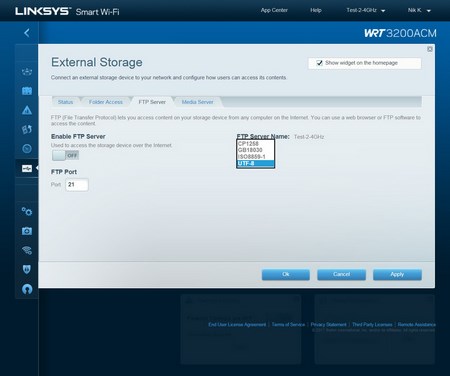
From the Smart WiFi Tools menu you can also enable/disable the guest access control (up to 50 guests), enable/disable parental controls (individual for each device), setup media prioritization (there are several software and game presets), perform an internet speed test (not really very reliable since it's the same as the ones we find online) and you can also setup external storage access.
SMART WI-FI INTERFACE PART 2






From within the router settings menu you can also adjust the wireless connectivity options, check for updates, enable/disable the activity/status LEDs, change the type of connection, enable/disable DHCP, configure static routing, enable and configure VLAN, enable/disable UPNP and setup remote access.
Linksys has placed a troubleshooting tab via which you can check the status of the router, share info with them, backup and restore its entire configuration, reboot the router, restore previous firmware version, perform diagnostics and read the logs.



Everything that has to do with wireless connectivity (network names, broadcast ID, passwords, WPS, scheduler) is placed under the wireless tab.





As expected from the security tab you can setup the firewall, VPN passthrough, set internet filters, configure DMZ, enable DDNS and finally you can also setup port forwarding.
Finally you can enable/disable the OpenVPN (open source virtual private network) feature.
TESTING METHODOLOGY
Since standalone routers can't directly connect to the internet (unless you have a cable connection which we don't) and thus the modem is responsible for internet speeds the only thing that's left is to test and see how much bandwidth they can offer by directly linking two devices with them. So once again we will be using the networking benchmark by Passmark (v.8), QCheck by Ixia and ATTO 2.47 (since April 2015) to test such devices the same exact way we test Powerline adapters and Modem/Routers. Since we need to test new features and specifications all routers are benchmarked with their highest available wireless standard/band (5GHz in this case). Our systems are outfitted with Kingston HyperX Predator 480GB PCIe SSDs, AC1200 USB 3.0 adapters (we expect new AC1900 ones soon) and CAT7 cables and are placed 15m away from the router with 3 concrete walls between them while each test is repeated a total of 6 times after which the average scores are recorded into our charts. Both systems have Windows 7 Ultimate SP1 installed with all the updates until the 24th of April 2017.
We’ve received several requests by some of you to also measure power consumption when testing modem/routers and although differences are not that great between similar models we decided to do so (average power consumption during tests is placed in our charts). Also again after many requests from April 2017 we will also do our best to measure wired USB performance of any modem/router or standalone router that gets to our lab with the help of Cystal Disk Mark v5.1.2 and a Samsung T1 250GB Portable SSD.
TEST RESULTS





CONCLUSION
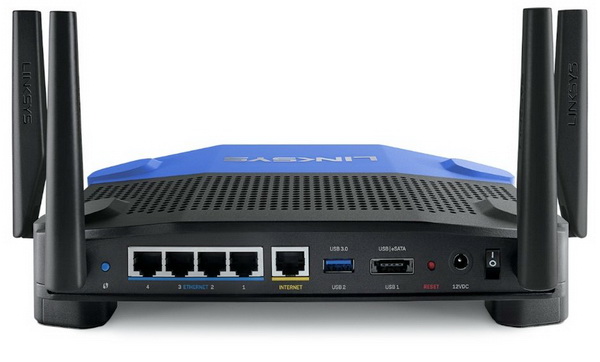
When Linksys launched the WRT1900AC and sent it over to us we really thought that it would be long until another router could match its performance and features something which stood true for quite a few months. Its successor the WRT1900ACS didn’t bring much more on the table but was a valid upgrade in terms of hardware even if that didn’t yield much more in terms of performance. At first glance the WRT3200ACM doesn’t seem to offer much in terms of performance compared to the WRT1900ACS and although right now that holds true that may change very soon due to its tri-band 160MHz technology. Of course we have no way of knowing when and even if the number of compatible devices will increase but after testing it with two WRT3200ACM routers we now for a fact that it can produce higher signal throughput especially over longer distances (not that there was a chance Marvell released it for no reason at all). Also after many of you requested that we also did tests to measure USB performance we decided to do so and to our surprise Linksys seems to clearly dominate that specific area (we didn’t expect that kind of difference to be honest).
Right now Linksys has a rather good offer on the WRT3200ACM AC3200 Smart Wi-Fi router so you can find it for just USD199.99 inside the USA (Amazon.com) and for 212Euros inside the EU (Amazon.co.uk). Its price tag may still not be able to match other equally good routers like for example the TEW-827DRU by TRENDnet but if you also take into account USB performance and available features (including open-source firmware compatibility and the tri-band 160MHz technology even though it’s not widely supported yet) the WRT3200ACM really has very little competition right now in the market and that’s why it gets our Platinum award.

PROS
- Build Quality
- Design
- Top Of The Charts Performance (Wireless, Wired & USB)
- AC3200 Technology (Concurrent 802.11n & 802.11ac)
- Features (Including Open Source Firmware Compatibility And Tri-Band Technology)
- 4 High Gain Detachable Antennas
- Smart Web Interface
- 4 Gigabit Ethernet Ports
- USB 3.0 Port & USB 2.0/eSATA Port
CONS
- Price (For Some)

 O-Sense
O-Sense





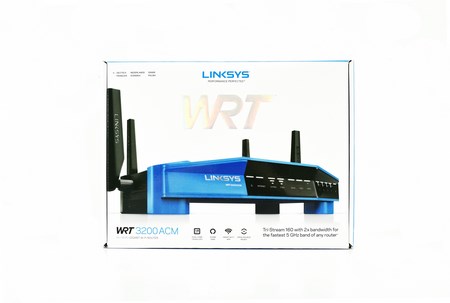













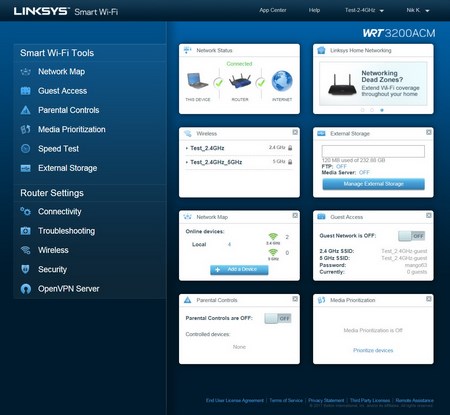




.png)

